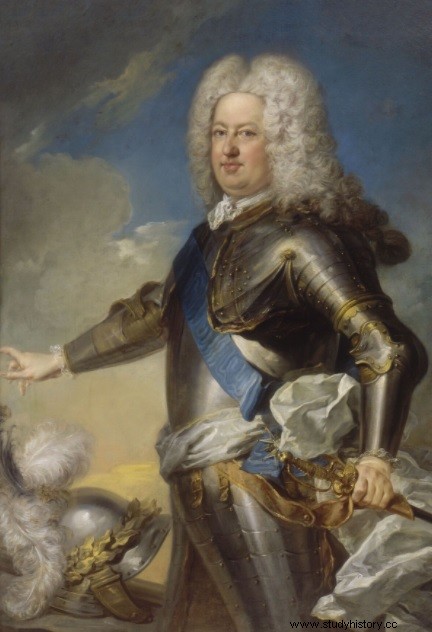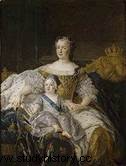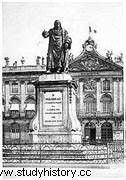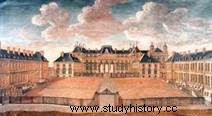 Elected King of Poland, Stanislaus I Leszczyński was forced to give up his throne in 1709, but regained it on the death of Augustus II (1733). If he is supported by France, Spain, Sardinia and Bavaria, his rival Augustus III (son of the deceased) receives for his part the support of Russia, Austria and Saxony. This dual candidacy provoked the War of the Polish Succession (1733-1735), at the end of which Stanislas renounced the Polish throne. He will receive in compensation the duchies of Lorraine and Bar. Constantly forced to flee, he was a philosopher, always in a good mood and knew how to take advantage of the life offered, saying moreover "he who has a lot is not the happiest:he is the one who desires little and who knows how to enjoy of what he has”. He is also the great-grandfather of three Kings of France:Louis XVI, Louis XVIII and Charles X.
Elected King of Poland, Stanislaus I Leszczyński was forced to give up his throne in 1709, but regained it on the death of Augustus II (1733). If he is supported by France, Spain, Sardinia and Bavaria, his rival Augustus III (son of the deceased) receives for his part the support of Russia, Austria and Saxony. This dual candidacy provoked the War of the Polish Succession (1733-1735), at the end of which Stanislas renounced the Polish throne. He will receive in compensation the duchies of Lorraine and Bar. Constantly forced to flee, he was a philosopher, always in a good mood and knew how to take advantage of the life offered, saying moreover "he who has a lot is not the happiest:he is the one who desires little and who knows how to enjoy of what he has”. He is also the great-grandfather of three Kings of France:Louis XVI, Louis XVIII and Charles X.
First steps in politics
Stanislas Leszczynski was born on October 20, 1677 into an influential family belonging to the great Polish nobility since the 16th century, his father being Palatine of Poznania, Grand Treasurer of the Crown, his mother daughter of a great general who defeated the Swedes and the Cossacks. He studied in Leszno in Greater Poland, learning science, mathematics, literature and speaks Latin, German, Italian and French perfectly. At the age of 18, his educational journey took him to Vienna, Venice, Rome, Florence, Paris, but he had to cut short his journey in 1696, on the death of King Jean Sobieski.
Holding the title of Count of Leszno, exercising the function of head of the province of Poznan, he took his first steps in politics and sat in the senate:Stanislas was elected to the diet which prepares the final election of the new king. Faced with two tough competitors (the Prince of Conti and the son of the previous king), he withdrew from the final vote and gave way to the King of Saxony, Frédéric Auguste crowned in Krakow in September 1697 under the name of Auguste II. Stanislas nevertheless has the honor of presenting the condolences of the assembly to the widow of King Jean Sobieski. He does wonders with his speaking skills.
At the age of 21 in May 1698, Stanislas married the daughter of a Polish magnate Opalinski and the Countess Catherine Opalinska, who gave him two daughters Anna in May 1699, and Marie in June 1703. She brings him as a dowry sixty towns and one hundred and fifty villages; he was thus at the head of an immense domain when Raphaël III his father died in 1703.
Stanislas Leszczynski Short-lived King of Poland
Charles XII king of Sweden refuses the alliance that Augustus II signs with Russia and Denmark against him. Conquered by the good nature of Stanislas, he will maneuver as much as he can to prove "the inability to reign" of Augustus II and install Stanislas on the throne. What is done on October 4, 1705 in Warsaw, not without difficulty because Augustus II tries to kidnap Stanislas! The new King of Poland could count on his "protector" until 1709 during the great defeat of Charles XII in Russia, who fled to the Turks. With the Russian and Saxon armies advancing on Warsaw, Stanislaus has only one solution left:to abdicate.
 While informing Charles XII, Stanislas took refuge in Stettin, then in Stockholm. He does not have the victorious temperament and the optimism of the King of Sweden, he knows that Poland would be even more unhappy if he persisted, he has lost all his possessions, and to top it off:he lodges a refugee in the foreign ! Meanwhile, Augustus II regains possession of Poland. Despite Charles XII's injunctions to hold on at all costs, Stanislas decided to join him in Turkey in the winter of 1712, disguised as a French officer. After a complicated journey, an arrest on arrival and a quick release, Stanislas beseeches the King of Sweden to accept his abdication. With a burst of understanding, Charles XII offered him the Duchy of Two Bridges in Germany, while waiting to find his kingdom of Poland.
While informing Charles XII, Stanislas took refuge in Stettin, then in Stockholm. He does not have the victorious temperament and the optimism of the King of Sweden, he knows that Poland would be even more unhappy if he persisted, he has lost all his possessions, and to top it off:he lodges a refugee in the foreign ! Meanwhile, Augustus II regains possession of Poland. Despite Charles XII's injunctions to hold on at all costs, Stanislas decided to join him in Turkey in the winter of 1712, disguised as a French officer. After a complicated journey, an arrest on arrival and a quick release, Stanislas beseeches the King of Sweden to accept his abdication. With a burst of understanding, Charles XII offered him the Duchy of Two Bridges in Germany, while waiting to find his kingdom of Poland.
Stanislas Leszczynski returns via Vienna and the Duchy of Lorraine. In Lunéville, in need, he pawns his jewels and despite the assumed name of Comte de Cronstein, he is recognized by Mr de Beauvau acquired by the Duke of Lorraine, who leaves him his jewels and advances the estimated amount.
At the beginning of July 1714, Stanislas arrived at Deux Ponts and discovered an old castle; the revenue is 70,000 crowns, but the four hundred Swedes in the garrison ate a good part of it. Being of good nature, Stanislas bends to this situation and three months later brings his wife and two daughters. He knew how to adapt to this new peaceful life, despite the premature death of his eldest in June 1717.
In Poland, Charles XII was still maneuvering for Stanislaus to regain the crown, although Augustus II tried again to capture Stanislaus in August 1717. Upon the death of the King of Sweden At the end of 1718, Stanislas was forced to change his residence:he first settled near Landau then took refuge in Wissembourg in 1719, thanks to the Regent Philippe d'Orléans who granted him a monthly pension of 4,000 pounds, the Duke of Lorraine granting him a loan of 30,000 pounds. He lacked the funds to settle down, Stanislas pawns his jewels and makes a proposal to Augustus II:he is ready to give up his crown if he recovers his property! Because you have to marry your second daughter who has just turned 18! The suitors are rare in front of the poverty of the family. Stanislas makes up his mind:he has a happy affair with the wife of a French officer, he philosophizes, hunts, walks and enjoys the quiet pleasures of life.
Louis XV's father-in-law
In France, after the departure of the Infanta of Spain who is too young, there remain seventeen suitors for the marriage of Louis XV out of the ninety-seven who left:either that they are not Catholics, or that they are poor like Stanislas' daughter. The Duke of Bourbon, acting as interim after the death of the Regent, proposes to marry Marie, Stanislas is happy with this outcome. He receives the portrait painter of the greats of the kingdom who leaves with the portrait of Marie in February 1725. At the beginning of April, the Duke of Bourbon asks him for the hand of his daughter... for the King of France!
 As Stanislas Leszczynski faints, there is consternation in France. But Louis XV was satisfied with the portrait "neither beautiful nor pretty, but with a fresh complexion, lively eyes, cultured, gentle character, a great kindness like his father". Stanislas, recovered from his fainting, will recover his pawned jewels, thanks to a loan of 13,000 pounds granted by the government of Strasbourg.
As Stanislas Leszczynski faints, there is consternation in France. But Louis XV was satisfied with the portrait "neither beautiful nor pretty, but with a fresh complexion, lively eyes, cultured, gentle character, a great kindness like his father". Stanislas, recovered from his fainting, will recover his pawned jewels, thanks to a loan of 13,000 pounds granted by the government of Strasbourg.
The marriage takes place by proxy on August 15, Stanislas receives good news at the beginning of September and then thinks "I have lost the throne of Poland, but my future grandson will ascend the throne of France":he was radiant with happiness. In 1729, Louis XV moved his in-laws to Chambord with a small pension, but the castle was empty. Accustomed to having little, Stanislas manages his funds and does not furnish everything; life is organized quietly between his devout wife, his mother who stuffs and stuffs himself, his walks in the forest, his readings "we live in a great tranquility which makes the sweetness of my life", by making a cross on his throne of Poland, because no one moves in France as long as Augustus II is alive.
Stanislas Leszczynski regains his throne of Poland…
Auguste II died in February 1733, several candidates presented themselves, including his son Auguste III and Stanislas Poniatowski, a former faithful of our Stanislas. The Marquis de Monti, French ambassador to Poland, will do everything to ensure that Stanislas regains his throne despite exile. Aided by the sympathetic party, he spent lavishly, explaining that Stanislas was supported by the King of France, that he would never invade Poland when the neighbors were threatening (Austria, Prussia, Russia), that he was even ready to defend them in the event of an invasion by one of the members of the Treaty of the Three Black Eagles (Germany, Russia and Prussia to ward off any Polish claimant to the crown).
As early as March 1733, Monti asked France to send him Stanislas…who did not move. Stanislas hesitates:he is sure of finding his throne, but not at all sure of the reception of the Poles; courageous and lucid, he sees that he does not have the support of the French Prime Minister:if war should break out, he could not count on France. Stanislas embarked in Brest in August 1733, then was stopped in Copenhagen by the Tsarina who closed the roads... Finally, he took a post chair, disguised as a German merchant's clerk. He arrived safely on September 8, with the election taking place on the 11th. The whole expedition had been organized by Monti, the action department of the Secret was working well. On September 10, Stanislas leaving the embassy is recognized, the population is in turmoil, no one had expected his presence! The next day, he was elected unanimously, minus three abstentions. At the same time, 5000 Poles deserted!
A regular at escapes
Barely elected, knowing that the Russian army is advancing, Stanislas then engages in two glorious battles; Faced with the number of assailants, having no regular army, he left Warsaw on September 22, joined Danzig and awaited the help of France.
 This help will never arrive, Louis XV having decided to declare war on the Emperor Charles VI (ally of the Russians invading Poland), setting up his army on the German border near Italy. This is the beginning of the "War of the Polish Succession". Augustus III was crowned on October 5, 1733 with the support of 40,000 Russians, 20,000 Saxons ravaging the country and 36,000 soldiers advancing on Danzig!
This help will never arrive, Louis XV having decided to declare war on the Emperor Charles VI (ally of the Russians invading Poland), setting up his army on the German border near Italy. This is the beginning of the "War of the Polish Succession". Augustus III was crowned on October 5, 1733 with the support of 40,000 Russians, 20,000 Saxons ravaging the country and 36,000 soldiers advancing on Danzig!
Relief finally arrives in April 1734, but only with 1950 men and 20 rifle bullets each! They quickly turn back, using "common sense" in the face of the size of the enemy troops. Faced with the ultimatum posed by the Russians "for the freedom of Danzig, the King of Poland must be delivered, or he will succeed in fleeing", the city is still fighting despite the exhaustion of the soldiers and the ambassador decides to an evacuation plan at the end of June:pass between the enemy posts, on the canals, cross the Vistula and reach Prussia.
After being strongly indignant because Cardinal de Fleury did not want to send help, Stanislas fled again while remaining in a good mood, helped by a general Swedish, both disguised as peasants. The journey does not always go as planned, Stanislas is "put back in place" by the guides, he is the King of Poland, father-in-law of the King of France! You shouldn't be difficult, it's no longer a question of keeping your throne, but of saving your skin, the enemy is everywhere and a price is put on his head "a strong reward to whoever brings him back dead or alive"!
The expedition lasts more than a week, through the canals, from farm to farm, in carts covered with goods, until he is rescued, welcomed by the King of Prussia in Koenigsberg at the beginning of July. Frederick William I offers him a guard of honor and a decent pension. A few days later, Danzig capitulated, the small group of followers of Stanislas was imprisoned in a castle near Marienburg by the Russian army.
At Versailles, no one dares to tell the Queen of France everything, so much so that special pamphlets favorable to Stanislas are printed! During this time, the King of France signs a famous treaty called Pragmatic Sanction:François III Duke of Lorraine marries Marie-Thérèse de Habsbourg ending the War of Succession of Poland, France recovering the duchies of Bar and Lorraine, in thinking of installing Stanislas there!
Stanislas Leszczynski reigns over the duchies of Bar and Lorraine
 The negotiations having lasted two years, Stanislas Leszczynski signed his abdication to the throne of Poland on January 27, 1736, harassed and forced by Versailles. Even his daughter pushes her father by showing him that Lorraine is not far away, that if Poland was not there, this new duchy would be just as good, and at least he would not be a king without a throne! Forced to sign the "secret declaration of Meudon" at the beginning of June with a condition "his Polish Majesty, not caring to take on the embarrassments which concern the administration of the finances and revenues of the duchies of Bar and Lorraine, abandon the concern to the King of France, now and forever", he receives an income of 2,000,000 pounds a year, a steward with the title of Chancellor, and the honorary title of King of Poland. Stanislas would reign without governing! And as he knows how to do it on all occasions, he takes it with philosophy.
The negotiations having lasted two years, Stanislas Leszczynski signed his abdication to the throne of Poland on January 27, 1736, harassed and forced by Versailles. Even his daughter pushes her father by showing him that Lorraine is not far away, that if Poland was not there, this new duchy would be just as good, and at least he would not be a king without a throne! Forced to sign the "secret declaration of Meudon" at the beginning of June with a condition "his Polish Majesty, not caring to take on the embarrassments which concern the administration of the finances and revenues of the duchies of Bar and Lorraine, abandon the concern to the King of France, now and forever", he receives an income of 2,000,000 pounds a year, a steward with the title of Chancellor, and the honorary title of King of Poland. Stanislas would reign without governing! And as he knows how to do it on all occasions, he takes it with philosophy.
Antoine Chaumont de la Galaizière, pushed by Cardinal de Fleury, took possession of the duchies in February and March 1737, having all the powers. Stanislas enters Lunéville on April 3 in front of a recalcitrant people, but finds Mr de Beauvau, an old acquaintance who had crossed his path 23 years earlier and who installs him in his private mansion. Stanislas is happy, he will take care of restoring the castle of Lunéville which is uninhabitable and that of Bar which is not furnished. Who could think that he will reign 29 years over his duchies and above all that he will be loved?
Stanislas "the Beneficent"
As soon as he arrived, Stanislas Leszczynski, who was not wanted, set to work by constituting his Council of State, Finance and Commerce; he puts his money into works, fights against scarcity, constitutes a kind of social security to deal with unforeseen events such as accidents, illness or infirmity, establishes free consultations with lawyers for the poor, founds an order of the congregation of the Brothers of the schools in 1748 and participates in the maintenance of schools to obtain free admission to several schools in Nancy. This good man "cuts corners" when his Chancellor imposes French laws.
All goes well until 1740, when the War of the Austrian Succession begins. Three years later, despite the French armies stationed in Strasbourg and faced with the advance of the Germans, Stanislas left Lunéville to take refuge in Metz. In 1746, he returned to Lorraine, took care of his castle which had burned down in 1744. Queen Catherine died in March 1747, the Marquise de Boufflers nicknamed "the Lady of Pleasure" became his mistress, Stanislas took advantage of life and grace to his passion for desserts he invents “le baba”:finding that the kouglof is too dry, he soaks it in rum. He finds all the faithful of his escapes:Thyange, the Chevalier de Solignac, Tercier and welcomes Montesquieu in 1747 and Voltaire in 1748-1749. Its courtyard is "more breathable" than that of Versailles, it is a haven of peace with a taste for things of the spirit!
Architect from Lunéville and Nancy
 Great works are undertaken in the castle of Lunéville, where he even created a throne room. He redesigned the gardens, had a Turkish-inspired kiosk installed there, a Chinese-style pavilion, a series of 88 automatons at the "Rocher" in 1742, had "the Chartreuses" built for the favorite courtiers so that they could hold a living room . Visitors come from far and wide to appreciate these marvels of Lunéville. Everything will be gradually destroyed by Louis XV on the death of Stanislas because the king wants to transform the castle into military barracks!
Great works are undertaken in the castle of Lunéville, where he even created a throne room. He redesigned the gardens, had a Turkish-inspired kiosk installed there, a Chinese-style pavilion, a series of 88 automatons at the "Rocher" in 1742, had "the Chartreuses" built for the favorite courtiers so that they could hold a living room . Visitors come from far and wide to appreciate these marvels of Lunéville. Everything will be gradually destroyed by Louis XV on the death of Stanislas because the king wants to transform the castle into military barracks!
In Nancy, he had the Church of Notre Dame de Bonsecours built in 1738, he reunited the medieval Old Town and the New Town, developed the Place Royale (future place Stanislas) inaugurated in 1755, created a large public library and a Royal Society of Sciences and Belles Letters in 1750 as well as the Royal College of Medicine in 1752.
Fatal day for Lorraine
On February 5, 1766, Stanislas Leszczynski got too close to the fireplace and his fur dressing gown (a gift from his daughter) caught fire. He tries to put out the start of the fire, but falls into the blaze. When the guard manages to enter the room, it is too late:an entire side of Stanislas' body is burned and one of his hands is charred.
Stanislas died seventeen days later, on February 23, 1766, at the age of 88. His remains rest in the vault of the Notre Dame de Bonsecours church, with his wife Catherine Opalinska.
Following the agreements made with Louis XV, Nancy became French and in 1831, the population installed a statue in her honor in the center of the Place Royale with the inscription " To Stanislas the Beneficent, grateful Lorraine .
Bibliography
- Stanislas Leszczynski, biography of Jacques Levron. Perrin, 2009.
- King Stanislas, by Anne Muratori-Philip. Historical Biographies, Fayard, 2000.
- When Stanislas reigned in Lorraine, by Guy Cabourdin.
